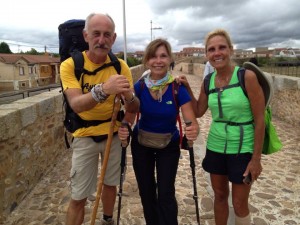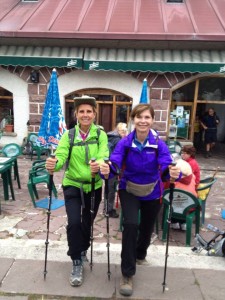Posted October 24, 2013
By SAMANTHA LUCCI
CAMINO DE SANTIAGO, Spain — Hundreds of miles of uneven dirt paths, grooved from the countless footsteps of travelers. Winding asphalt roads that approach the edges of steep rock faces and lead into remote Spanish towns. Intermittently sharp inclines, gently sloping hilly terrains, and grassy plateaus that reveal no end in sight.

Joni Lucci overlooks what pilgrims used to believe was “the end of the earth” after finishing the Camino de Santiago (Photo by Debbie Garson).
These are just some of the physical landscapes that confront pilgrims— known as “peregrinos” to locals— along the Camino de Santiago in northwestern Spain.
Translated to mean “the Way of St. James,” this historical pilgrimage makes tough spiritual and physical demands of those who choose to take on the challenge.
What began as an ancient religious journey that started from a pilgrim’s own home and ended at the tomb of the Christian St. James, has taken on a much broader range of meanings. People from all corners of the world come to the Camino in search of entirely different things. Some seek spiritual enlightenment. Others hope to heal their hearts, or to unburden sorrow. While others look simply to test their physical strength and endurance.
Whatever the various reasons for coming, one thing remains true for all: The Camino is no joke.
For two pilgrims, my mother, Joni Lucci, 55, and her close friend, Debbie Garson, 56, taking on the Camino was an item on their bucket lists. It is something they have trained and prepared for, for the better part of a year. Friends from Cleveland, Ohio, Lucci and Garson officially began their long-anticipated journey on Sept. 3.
One month on the trail has taught them a number of things about how to complete the Camino. One month on the trail has taught them a number of things about how to live. To anyone planning to take on The Camino, Lucci and Garson offer a few words of advice.
Have a plan, but be flexible.
Sit down with your partner well before you leave to plan your trip.
“We spoke to a travel agent to find the best and cheapest ways to get to the Camino about three to four months before we left. We researched the different paths pilgrims take to reach the end and picked the one we liked best. Then we even looked up the towns we would pass along the way. We didn’t book albergues (overnight lodgings much like hostels) until a couple of days in advance or sometimes not even until we got there. That wasn’t the smartest move though. We almost got shut out a couple of times,” Lucci said.
The two women mapped their route and determined a certain number of miles they needed to travel each day, usually based off of a particular town they needed to reach, in order to reach their final destination by their Oct. 15 deadline.
Though both women speak of the importance of having a plan, they both agree that it is essential to not be too rigid in your plan.
“Don’t hesitate to take a day of rest or reflection. Stop and spend extra time in a town that piques your interest. Relax and eat meals that last for hours. And always end the day with a glass of wine,” said Garson.
They make sure to note that, if you do plan to spend an extra day somewhere you were not originally supposed to, it is a common courtesy to call the owners of the albergue where you were supposed to stay in advance to notify them that you will not be coming at the time you had said. Hundreds of people hike the Camino every day. Rooms are always needed.
Travelers should also call in advance if they are going to arrive later than expected, even if it is on the same day. One day, Lucci and Garson we were late in arriving. They got to their albergue a couple of hours behind schedule and the owners had given up our spots to other travelers.
“You have to get used to the ‘take it or leave it’ attitude. That’s something in customer service that, as Americans, we aren’t really used to,” said Garson.
Take time to reflect.
According to Lucci and Garson, the Camino is less about reaching the end than it is about discovering things you never even knew about yourself.
“Test your limits,” they advised. “The journey is as much spiritual as it is physical. So, step outside of your comfort zone. Take in the sights and smells around you. Record and reflect on everything you experience that is of any meaning to you. I’m sure that I’ll thank myself later for that,” said Garson, who uses Facebook to write a daily post about their adventures on the road.
Reach out to others.
People make the Camino what it is. Experiencing others on the path is as much a part of the Camino as actually hiking it. There are times to go the solo route, to plug in your headphones and to forge on ahead. Then there are times to make an effort to talk to and to help the people that you see on the path.
“We picked up a couple of friends along the way,” said Lucci. “None who stayed with us as long as Egon, the Wiseman from Holland. We met him about a week into the trip and he’s stayed with us this far.”

Egon Mes, Debbie Garson and Joni Lucci stop while crossing a bridge on their way to Astorga, a city along the Camino de Santiago (Photo courtesy of Joni Lucci).
One day the two women passed a fellow pilgrim who had passed out on the side of the trail. They had thought he was resting, but Egon knew better. He was an older man. He had likely passed out from heat exhaustion. They picked up speed to get to the next town to quickly call for help.
On their way they passed another couple coming back in a taxi to help the fallen pilgrim. Even though each person chooses to do the Camino for their own reasons, there is a sense of companionship and solidarity that arises when people leave their comfort zones. There is a family of pilgrims to be found out there.
Lucci and Garson are currently a month into their travels. Garson now ends her Facebook posts “xoxoxo Joni, Debbie and Egon.”
Pack smart. Pack light:
When you are hiking anywhere between 10 to 20 miles a day or more, the last thing you want is a lot of stuff to carry.
On the Camino, Mother Nature does not care how many miles you are hiking that day. Prepare for unpleasant weather; be that extreme heat, cold or rain, the two women agreed. Before their departure, they each invested in durable, lightweight clothing for all elements. A period of about four days of intermittent rain while hiking made the two women grateful for their foresight.
Most important of all, you must “let go of the unnecessary burdens,” they both said. “Bring only what you need.”
For Lucci, leaving her hairspray behind was difficult. “For the first couple of days she stopped in every town we passed to check for hairspray products that she could add to her bag,” said Garson. “She would literally hold the bottle in her hands weighing her options, whether it was worth it or not to add to her load. Eventually she let it go.”
Two things make travel more difficult: a heavy suitcase, and a heavy heart. One of the rituals along the Camino is the legend of the Sorrow Stones. It has been said that if a pilgrim picks up a stone and puts all of his or her sorrow into it, when they leave the stone behind they also leave their sorrow behind.

Joni Lucci and Debbie Garson prepare for a 15 mile hike from Roncevailles to Zubiri along te Camino de Santiago on the second day of their journey (Photo courtesy of Joni Lucci).
For many, the journey is about letting go of pain or heartache. People who hike the path may even bring their own stones from home, often decorated with the names of loved ones who have passed or hardships that they have had to endure. Some bring stones for those they have left behind, to ease their burden of sorrows, too.
“Make room in your bag for the stones,” Lucci said. “You’ll come with a heavy bag, but you’ll leave behind a heavy heart.”
Things to bring to the Camino: comfortable and durable, weather-appropriate clothing.
Things to bring back from the Camino: a lighter heart, an enriched spirit and soul, and an enlivened zest for life.
From Joni and Debbie (and Egon!): “Buen camino, peregrinos!”
